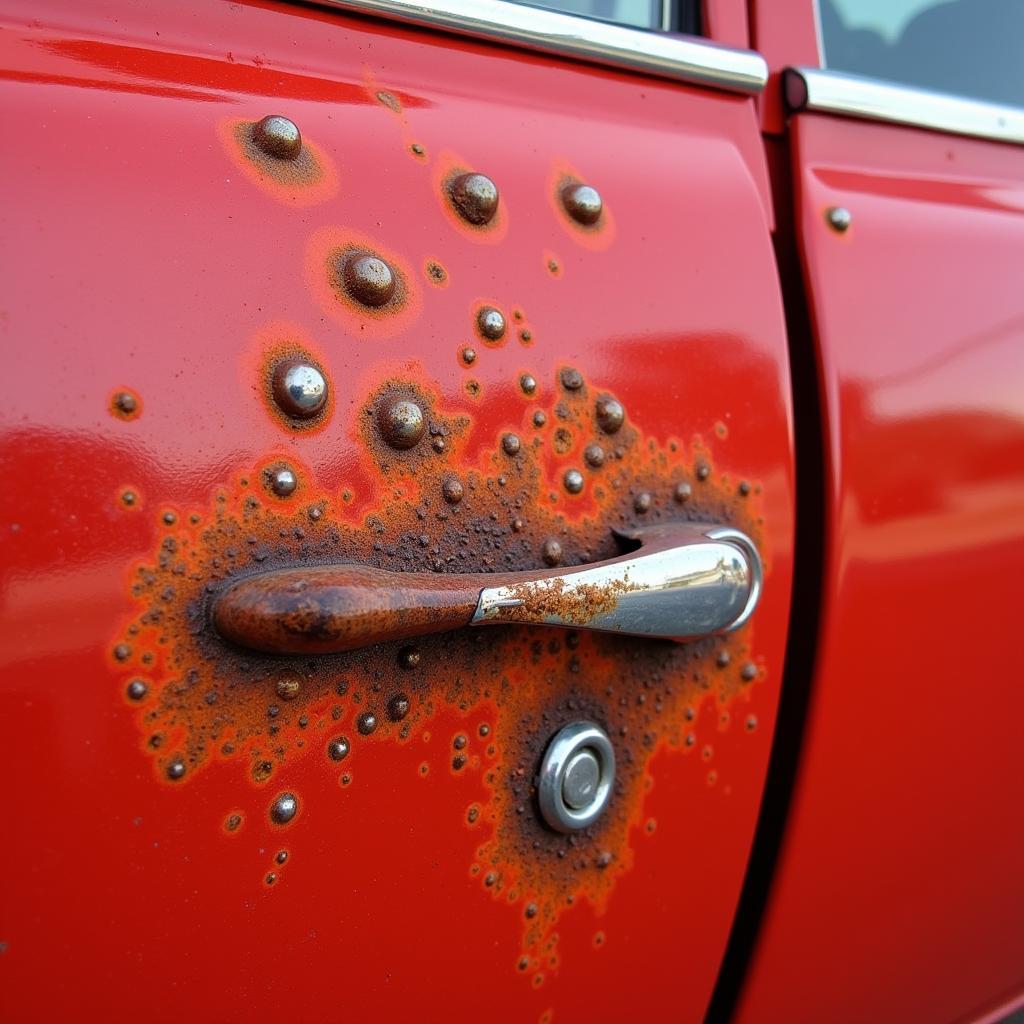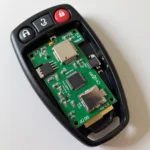Rust bubbles on your car’s paint are a telltale sign of corrosion creeping in beneath the surface. Ignoring them will only lead to more extensive and costly damage down the road. This guide will walk you through how to repair rust bubbles on car paint, preventing further deterioration and restoring your car’s appearance. Let’s dive in and learn how to tackle this common car problem effectively. You can also learn more about how to repair micro paint blisters on car.
Understanding the Enemy: Why Rust Bubbles Form
Rust bubbles, also known as paint blisters, occur when moisture penetrates the paint layers and reaches the bare metal underneath. This triggers an oxidation process, forming iron oxide (rust). As the rust expands, it pushes up against the paint, creating the characteristic bubbles you see. Factors like road salt, stone chips, and scratches accelerate this process.
Knowing why rust forms helps in prevention. Regular washing and waxing can protect your car’s paint and prevent moisture from reaching the metal. Addressing minor paint chips promptly can also prevent rust bubbles from forming in the first place.
Gathering Your Rust-Busting Arsenal: Tools and Materials
Before you begin, assemble the necessary tools and materials. This will ensure a smooth and efficient repair process. You’ll need:
- Sandpaper (various grits, from 180 to 2000)
- Rust remover or converter
- Primer
- Automotive paint (matching your car’s color)
- Clear coat
- Masking tape and paper
- Safety glasses and gloves
- Putty knife or plastic spreader
- Clean cloths
- A sanding block
Having the right tools and materials is crucial for a successful rust repair. Using quality products will ensure a longer-lasting and more professional-looking finish. Check out our guide on car paint bubble repair for more detailed information on product recommendations.
The Step-by-Step Rust Repair Process
Now that you’re prepared, let’s get to the heart of the matter – fixing those rust bubbles. Follow these steps carefully for optimal results.
-
Clean the Area: Thoroughly wash and dry the area around the rust bubbles. This removes dirt and debris, ensuring proper adhesion of the repair materials.
-
Sanding Down: Using coarse sandpaper (around 180 grit), sand down the affected area until all the bubbles are gone and bare metal is exposed. Feather the edges of the sanded area to create a smooth transition.
-
Rust Treatment: Apply a rust remover or converter to the exposed metal. Follow the product instructions carefully. This neutralizes the rust and prevents it from spreading. You can find more information on car paint corrosion repair in our dedicated guide.
-
Priming: Apply a thin, even coat of automotive primer to the sanded and treated area. Allow the primer to dry completely according to the manufacturer’s instructions. This creates a foundation for the paint to adhere to.
-
Painting: Apply several thin coats of automotive paint that matches your car’s color. Allow each coat to dry before applying the next. This ensures a smooth and even finish. For minor touch-ups, consider car paint repair stickers.
-
Clear Coat Application: Once the paint is dry, apply a few thin coats of clear coat. This protects the paint and adds a glossy finish.
-
Final Sanding and Polishing: After the clear coat has cured, lightly sand with fine-grit sandpaper (2000 grit) and polish the area to blend the repair seamlessly with the surrounding paint.
This detailed process ensures a professional-looking repair that will protect your car from further rust damage. Remember, patience and attention to detail are key to achieving a flawless finish. Learn how to deal with bat poo on car paint repair, another common car paint issue.
Preventing Future Rust Bubbles
Prevention is always better than cure. Here are some tips to keep your car rust-free:
- Regular Washing and Waxing: This protects the paint and prevents moisture from reaching the metal.
- Promptly Repairing Chips and Scratches: Small imperfections can become entry points for moisture and lead to rust.
- Garaging Your Car: Protecting your car from the elements can significantly reduce the risk of rust.
By taking these preventive measures, you can keep your car looking its best and avoid costly rust repairs in the future.
Conclusion
Repairing rust bubbles on your car paint might seem daunting, but with the right tools, materials, and a bit of patience, you can achieve professional-looking results. Addressing rust early prevents further damage and preserves your car’s value. Remember, regular maintenance is key to keeping your car in top condition and avoiding costly repairs down the line. So, tackle those rust bubbles today and enjoy a rust-free ride!
FAQ
- Can I use regular spray paint for this repair? It’s best to use automotive paint for a durable and color-matched finish.
- What if the rust is extensive? For severe rust, professional repair might be necessary.
- How long does the repair take? The process can take a few hours, including drying time.
- Can I prevent rust completely? While complete prevention is difficult, regular maintenance can significantly reduce the risk.
- What if the rust returns after repair? This could indicate a deeper rust issue requiring professional attention.
- What kind of rust remover should I use? A phosphoric acid-based rust remover is generally recommended.
- Do I need to use a clear coat? A clear coat protects the paint and provides a glossy finish.
Other Common Car Paint Questions We Answer
You might also be interested in learning about:
- How to remove scratches from car paint
- DIY car paint touch-up techniques
- Protecting your car paint from sun damage
- The best car waxes for different paint types
For more helpful tips and guides, browse our other articles on CarRepairOnline.
Need Help? Contact Us!
For any assistance or inquiries regarding car repair and diagnostics, feel free to reach out to us via WhatsApp: +1(641)206-8880 or Email: [email protected]. Our customer service team is available 24/7 to assist you.


